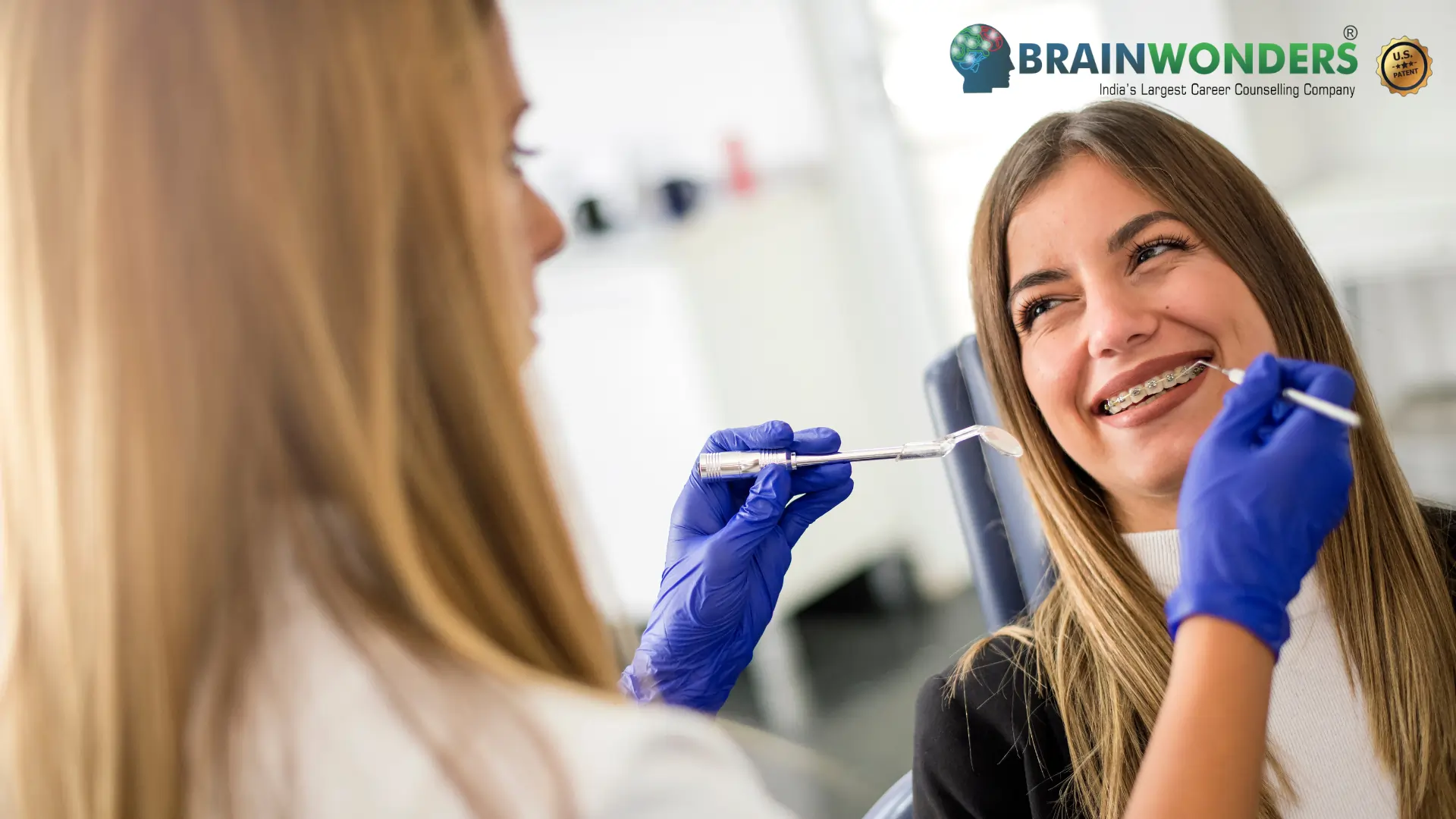How to become an Orthodontics
Overview, Courses, Exam, Colleges, Pathways, Salary

Overview
Who is Orthodontics ?
Orthodontics is a specialized branch of dentistry that focuses on diagnosing, preventing, and treating dental and facial irregularities, primarily involving the alignment of teeth and jaws. Orthodontists are dental professionals who specialize in orthodontic treatment.
After dental school, orthodontists undergo additional years of education and training to acquire expertise in the field. They possess in-depth knowledge of dental and facial anatomy, growth and development, and the mechanics of tooth movement. Orthodontists use various techniques, appliances, and treatments to correct malocclusions, which are improper bites caused by misaligned teeth or jaws.
Orthodontic treatment aims to improve the function, aesthetics, and overall oral health of patients. Common orthodontic conditions treated by orthodontists include crowded or crooked teeth, overbites, underbites, crossbites, open bites, and gaps between teeth.
Orthodontic treatment may involve braces, which are bonded brackets and archwires that apply gentle pressure to move teeth into their proper positions. Other appliances, such as clear aligners, retainers, and functional appliances, may also address specific orthodontic issues.
Orthodontists work closely with patients of all ages to develop personalized treatment plans and monitor progress throughout treatment. They collaborate with other dental specialists, such as oral surgeons and periodontists, when necessary.
The orthodontic treatment enhances the smile's appearance and improves oral health by improving bite functionality and making oral hygiene practices more effective. Orthodontics aims to achieve a balanced and harmonious bite, leading to optimal oral health and a confident smile.
Typical day at work
What does Orthodontics do?
Orthodontists are dental specialists who diagnose and treat various conditions related to misaligned teeth and jaws. They use various techniques, tools, and appliances to straighten teeth, close gaps, correct bites, and improve dental alignment.
Here are some common issues that orthodontics can address:
- Malocclusions: These refer to improper bites, such as overbites (upper teeth protrude over lower teeth), underbites (lower teeth protrude beyond upper teeth), crossbites (upper and lower teeth do not align properly), and open bites (teeth don't meet when biting down).
- Crowding: When there is insufficient space in the mouth for teeth to align correctly, they may become crowded, overlapping, or twisted. Orthodontic treatment can help create space and align the teeth correctly.
- Spacing issues: Gaps or spaces between teeth can be closed using orthodontic techniques, providing a more aesthetically pleasing smile and preventing food impaction.
- Improper dental midline: The midline is an imaginary line that divides the upper and lower dental arches. Orthodontics can correct cases where the midline does not align with the facial midline.
- Facial asymmetry: Orthodontic treatment can help address skeletal or dental imbalances contributing to facial asymmetry, improving function and appearance.
Abilities and Aptitude needed
What are the skills, abilities & aptitude needed to become Orthodontics?
- Strong academic foundation: Orthodontists must have a solid educational background in dentistry. They must complete a bachelor's degree followed by a dental degree (Doctor of Dental Surgery or Dental Medicine). Excellent performance in these programs is essential to build a solid knowledge base in oral health and dental sciences.
- Attention to detail: Orthodontics involves intricate work with teeth and jaws. Orthodontists must possess exceptional attention to detail to analyze and assess dental conditions accurately, develop treatment plans, and make precise adjustments to dental appliances or braces.
- Problem-solving and critical thinking: As orthodontic cases can be complex, orthodontists must possess strong problem-solving and critical thinking skills. They must evaluate patients' conditions, identify the underlying causes of dental misalignments, and determine the most appropriate treatment approach.
- Manual dexterity: Orthodontic procedures require precise manual dexterity. Orthodontists must have steady hands and the ability to work within the limited space of a patient's mouth, manipulating dental instruments and appliances with precision and care.
- Communication and interpersonal skills: Orthodontists work closely with patients, interacting with them during consultations, treatment discussions, and follow-up visits. Practical communication skills are crucial for building rapport, explaining treatment plans, and addressing patient concerns. Collaboration with other dental professionals, such as dental hygienists and orthodontic assistants, also requires strong interpersonal skills.
- Analytical and scientific mindset: Orthodontics relies on evidence-based practice and scientific principles. Orthodontists must stay updated with the latest research and advancements in the field. An analytical mindset helps them interpret research findings, evaluate treatment outcomes, and make informed patient decisions.
- Patience and empathy: Orthodontic treatment often involves long-term processes, and patients may sometimes experience discomfort or frustration. Orthodontists should be patient, understanding, and empathetic, supporting their patients throughout treatment.
- Continuous learning: The field of orthodontics evolves, and new techniques and technologies emerge regularly. Orthodontists should commit to lifelong learning, staying abreast of advancements through continuing education courses, seminars, conferences, and professional literature.
Pathways
How to become an Orthodontics?
Entrance Exam
Entrance Exam for Orthodontics ?
Courses
Which course I can pursue?
Best Colleges
Which are the best colleges to attend to become an Orthodontics?
Industries
Which Industries are open for Orthodontics?
- Private Practice: Many orthodontists establish private practices, providing orthodontic treatment to patients of all ages. Private practices offer independence and the opportunity to build a dedicated patient base.
- Group Practices: Orthodontists can join or form group practices, where multiple dental specialists work together to provide comprehensive dental care. Group practices may include general dentists, oral surgeons, periodontists, and other dental professionals.
- Hospitals and Medical Centers: Some orthodontists work in hospitals or medical centres as part of the dental department or in collaboration with other healthcare professionals. They may treat patients with complex dental needs or work with individuals requiring orthodontic care as part of a multidisciplinary medical team.
- Academic Institutions: Orthodontists can pursue academic careers by joining dental schools, universities, or research institutions as faculty members. They may teach orthodontic principles to dental students, conduct research, and contribute to advancing orthodontic knowledge.
- Research and Development: Orthodontists can research and develop within the dental industry. They may work in research institutes or collaborate with dental manufacturers to develop new orthodontic techniques, materials, and appliances.
- Orthodontic Specialty Clinics: Specialised orthodontic clinics focus solely on orthodontic treatment. These clinics may have multiple orthodontists working together and offer many orthodontic services.
- Public Health: Orthodontists can contribute to public health initiatives by working in community health centres, government healthcare facilities, or nonprofit organisations. They may provide orthodontic care to underserved populations, participate in public health campaigns, and promote oral health awareness.
- Orthodontic Consulting: Orthodontists with expertise and experience may offer consulting services to dental practices, insurance companies, or dental product manufacturers. They can guide treatment planning and case evaluations or contribute to product development and marketing strategies.
internship
Are there internships available for Orthodontics?
- Orthodontic Residency Programs: After completing dental school, individuals interested in specializing in orthodontics can apply for orthodontic residency programs. These programs typically last 2-3 years and provide intensive clinical orthodontics training under experienced orthodontists' supervision. Residents gain practical experience in diagnosing and treating orthodontic cases, working with different types of appliances, and managing patient care.
- Dental School Clinical Rotations: During dental school, students often have the opportunity to participate in clinical rotations in various dental specialities, including orthodontics. These rotations allow dental students to observe and assist orthodontic specialists in their practice, gaining exposure to different treatment techniques and patient management.
- Externship Programs: Some orthodontic practices offer externship programs where dental students or recent graduates can spend a designated period working closely with orthodontists. Externships provide an immersive experience, allowing participants to observe and assist with orthodontic procedures, interact with patients, and gain insight into the day-to-day operations of a practice.
- Research Internships: Individuals interested in orthodontic research may seek internships or research assistant positions in academic institutions, research laboratories, or dental industry settings. These internships involve working on ongoing research projects, collecting and analyzing data, and contributing to scientific publications.
- Continuing Education Courses: After completing orthodontic training, practising orthodontists can further enhance their skills and knowledge through continuing education courses and workshops. These programs often include hands-on training sessions where orthodontists can refine their techniques, learn about the latest advancements in orthodontics, and interact with experts in the field.
Career outlook
What does the future look like for Orthodontics?
The future of orthodontics looks promising as technological advancements continue to shape the field. Digital imaging, 3D printing, and computer-aided design are revolutionizing treatment planning and the production of orthodontic appliances. Invisalign and other transparent aligner systems are becoming more popular, offering discreet alternatives to traditional braces. Additionally, tel orthodontics is emerging, allowing remote monitoring and virtual consultations. The focus on personalized treatment approaches and shorter treatment times is expected to increase patient satisfaction. Overall, orthodontics is poised to become more efficient, convenient, and tailored to individual needs.







